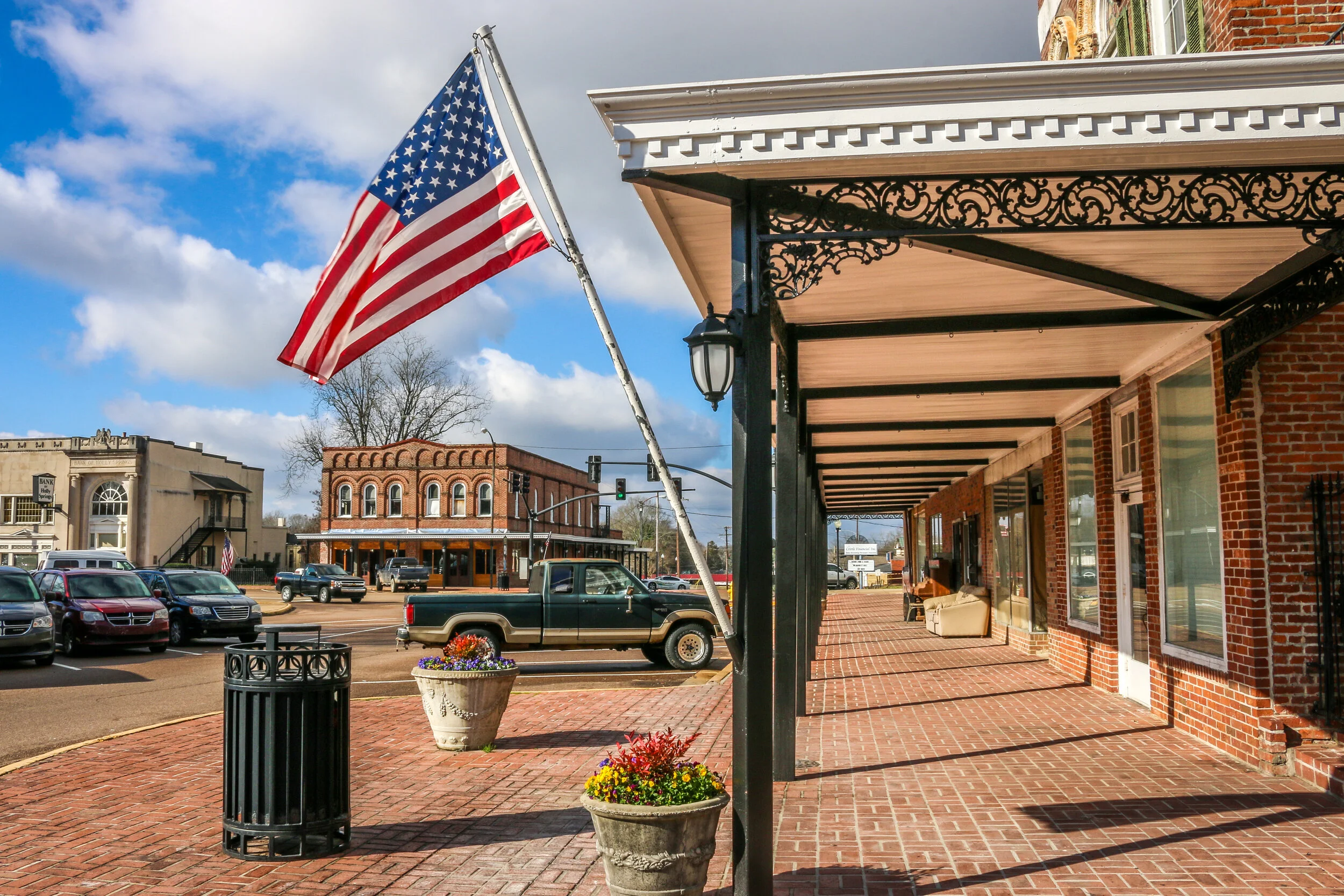Holly Springs was founded in 1836 on land previously occupied by the Chickasaw people after the Treaty of Pototoc Crreek forced them west. New settlers came to the region quickly and scrambled to buy up land and start planting cotton. As the county seat, Holly Springs grew rapidly as well and even more-so when the Mississippi Central Railroad came through in 1855. During the Civil War, the strategic nature of the railroad came into play and Holly Springs was occupied by Ulysses S. Grant and his Army of the Tennessee. Confederate Cavalry Commander Earl Van Dorn rode into Holly Springs before dawn on December 20th, 1862. The surprise attack temporarily cut off the Union supply route as Van Dorn’s men took all the supplies they could carry and burned the rest. After the war, Holly Springs would resume its role as a cotton center and railroad hub. Rust College was established in Holly Springs in 1866 to help educated newly freed slaves in the area. The college is still in operation today, making it one of the oldest Historically Black Colleges and Universities in the South.
Holly Springs today is a pleasant town of about 7500. I was thrilled to see construction going on while I was there and to find a Mississippi town which is growing and improving instead of deteriorating. There are a number of wonderful Antebellum homes to see in town, and the bustling town square has several restaurants and coffee shops when you get hungry. When I was there, I stopped in to the Visitors Center and spoke with Jamie who was super helpful in pointing out all the wonderful things Holly Springs has to offer. It should definitely be your first stop when you go to visit. I had a great day in Holly Springs and loved taking the photos you’ll see in this post. It’s a town on the rise, and I look forward to seeing how far it’s gotten the next time I’m in town.
St. Francisville, Louisiana may be small, but it sure packs a big punch. This beautiful Southern town got its start way back in 1809. It was built on a hill overlooking the older French settlement of Bayou Sara, which was at one time the largest port on the Mississippi River between New Orleans and Memphis. For 74 days back in 1810, St. Francisville served as the capital city of the independent Republic of West Florida when it ousted its Spanish occupants before being annexed by the United States. In the years leading up to the Civil War, St. Francisville was the supply center and main town for surrounding plantations, perfectly situated for trade on a bluff high above the river. Today it contains a fascinating collection of antebellum, creole and Victorian homes, and some beautiful churches and businesses as well. I spent a lovely afternoon there, wandering the quiet streets and taking these photos. The few people I met on my stroll were remarkably pleasant and kept pointing me towards even more beautiful parts of town for me to shoot. The river has been high this year, and you’ll see a few photos at the end of the flooding in the area. St. Francisville is a wonderful escape from the big cities and offers a magical combination of small-town charm, fascinating history and delightful people. You should definitely put it on your list!
Established in 1846 on an old plantation, Bonaventure Cemetery is the largest municipal cemetery in the city of Savannah. It gained notoriety from John Berendt’s novel Midnight in the Garden of Good and Evil and it’s film adaptation, and is one of the more visited sites in Savannah with several companies offering tours. It was also featured in John Muir’s Thousand Mile Walk, as he camped out in the cemetery for 6 days on his journey. I visited Bonaventure by myself and enjoyed wandering through this peaceful park. The Spanish moss gives it so much Southern atmosphere. Bonaventure is the final resting place of Savannah’s own Johnny Mercer and many other notable people from the city. It also has some magnificent statues. I hope you enjoy these photos from beautiful Bonaventure Cemetery…
While all modern forms of music have roots somewhere, it’s always fascinating to trace them back and try and discover where they came from and how they evolved. The blues will take you back to Dockery Farms in Mississippi and jazz to Congo Square in New Orleans, although the influences of those music forms go back much further. Hip-hop got its start in New York City. Many would say Sun Studios in Memphis was where rock and roll was born, although I tend to think otherwise. Each genre tends to have its early influences and groundbreaking shifts which led to how we define them today. Bluegrass music really gained that definition in the mid 1940’s when Earl Scruggs and Lester Flatt joined the already extant band The Bluegrass Boys. There is no doubt though that the man who brought them together and nurtured the evolution of the sound was the founder of that group and the undisputed Father of Bluegrass: Kentucky native Bill Monroe.
Bill Monroe was born in a small house on Pigeon Ridge in central Kentucky. That house was torn down and a new one built in its place when Bill was a kid…
Louisville’s Cave Hill Cemetery was dedicated in 1848 and is the final resting place for over 120,000 people. During the Victorian Era and in a time before city parks were as prevalent as they are today, “garden cemeteries” were often designed and promoted for recreational activities. People would stroll down the winding lanes and maybe have a picnic by the lake. I like this idea and have always seen beautiful cemeteries as a nice place to walk and think and ponder life and death, a place to consider and draw from generations of people who came before us. Funerary art and statues are remarkable and often overlooked as a true art form. I spent several hours in Cave Hill over two visits, neither under the best of conditions for photography, but it was beautiful nonetheless. You will see photos of some of the famous people buried there like Colonel Harland Sanders, Muhammad Ali and Louisville founder George Rogers Clark. There are also lesser known people like Harry L. Collins, who was the official magician of Frito-Lay and Nicola Marschall who designed the official flag and uniforms of the Confederacy. Cave Hill is also a National Cemetery with graves for both Union and Confederate war veterans. It is a beautiful place to visit and was high on my list of sites I wanted to see in Louisville. I hope you enjoy my photos from Cave Hill.
I have written about Billy Tripp's Mindfield in passing in a few other posts, but I don't think they really conveyed how striking it was and how much I saw in it. I also don't think I can necessarily describe the ways it affected me in words, so I thought I would do a pictorial post just on Mindfield and some of the smaller details of it. Billy Tripp started building Mindfield after his parents passed away in 1989. An artist and an incredibly skilled welder, Billy kept adding to it and it just went from there. As he healed, he built, and as he built, it grew, and as it grew, it took on a life of its own. Mindfield is now a destination, and people travel from all over the world to Brownsville, Tennessee to see it.







